December 26, 2017
I didn’t grow up eating crostoli.
That doesn’t mean we didn’t have our own version of fried dough.
Unlike crostoli, which are thin and crispy and leavened with baking powder, I grew up eating ovals of fried yeasted bread dough sprinkled with granulated sugar.
Frying bread dough and sprinkling it with granulated sugar is a common among Southern Italians. My mother had a name for it that I’ve never heard anywhere, it sounded something like “pitla.” I started doing some research. The word “pitta” is still used in Calabria, where my mother’s family originated, for various types of dough-based foods, including some that are quite flat. The word “pitta,” which I believe derives from the Greek word “pita,” became the word “pizza” in standard Italian. I’m guessing that “pitla” is a dialectical variation of “pitta.”
Click HERE to join our mailing list and you’ll never miss a recipe again!
One of the positive outcomes of doing research on Italian fried dough products is that I came across a wonderful Wikipedia page on fried dough from around the world. Check it out here.
Crostoli (or crostui in the Friuli-Venezia-Giulia region of Italy where my mother-in-law was born) are traditionally served at Christmastime. My mother-in-law says that they would sometimes have them at other times of the year when they “wanted something sweet” that was simple to make.
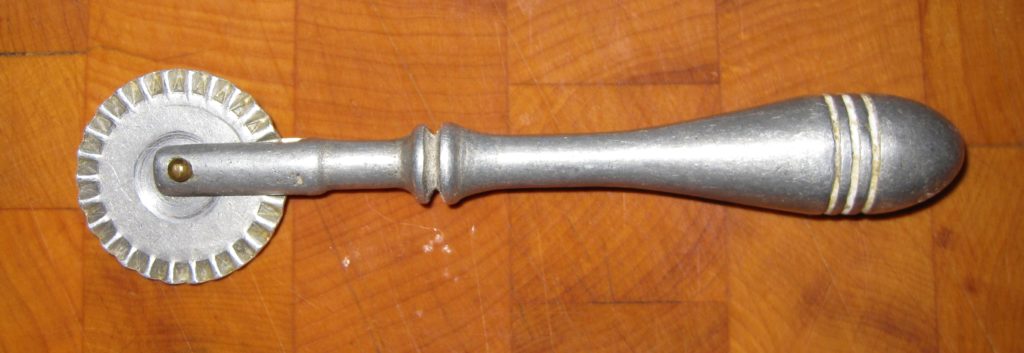
Not growing up eating crostoli, I asked my husband to tell me what he remembered.
I got two sentences:
“We always had them at Christmas.”
“They’re not my favorite.”
There you have it, the entirety of the crostoli story in 10 words.
I even waited a couple of days and asked him again if he remembered anything else about crostoli. “Nope” was the answer.
Now we’re up to 11 words.
Follow us on your social media platform of choice
That might have been the end had it not been for Christmas Eve. The morning of Christmas Eve, after I mixed dough for panettone, my mother-in-law and I made up a batch of crostoli to take to Christmas Eve dinner at the home of our friends Rich DePippo and Doug Howe.
Rich’s grandfather was from Domegge di Cadore in the Veneto region of Italy, just next door to Friuli-Venezia-Giulia where my mother-in-law was born. In fact, Domegge is about 100 kilometers from Treppo Grande, my mother-in-law’s home town.
As it turns out, Rich and his mother, visiting for Christmas, also made crostoli the morning of Christmas Eve.
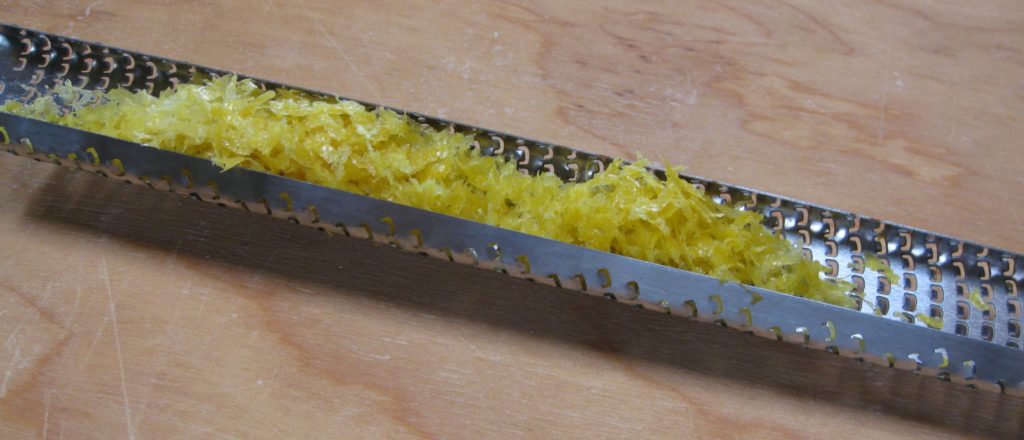
There were dueling crostoli served for dessert (along with pizzelle, nut roll, and biscochitos).
Rich’s were long and thin, with a slit cut in the middle through which one end of the dough was twisted before frying. This seems to be the most traditional shape that I’ve seen in my research, though Lidia Bastianich, who is also from very near where my mother-in-law was born, ties hers in a knot.
Having seen pictures of crostoli twisted and tied before embarking on making them with my mother-in-law, I asked her why hers were just left as irregular squares (well, quadrilaterals, really) of dough. That’s the way her mother made them was, of course, the first response. After which she added that she liked them to puff up, which they don’t do if they’re twisted or tied.
The other difference in the crostoli is that Rich used anisette to flavor his whereas my mother-in-law used lemon zest and vanilla.
The anisette was definitely a new twist. In researching crostoli, I’ve seen citrus, usually lemon or orange, as the most common flavoring. Often vanilla is added; sometimes brandy or rum. Never have I run into a recipe with anisette. Hopefully Rich will weigh in on his family’s recipe for crostoli and how they came to use anisette for flavoring.
Meanwhile, enjoy!
If you have a favorite family recipe and a bit of a story to tell, please email me at santafecook@villasentieri.com and we can discuss including it in the blog. I am expanding the scope of my blog to include traditional recipes from around the country and around the world. If you haven’t seen Bertha’s Flan, it will give you an idea of what I’m looking for.
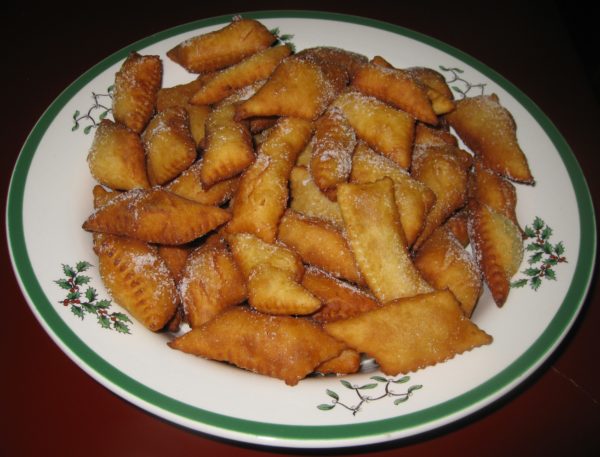
| Prep Time | 30 minutes |
| Cook Time | 45 minutes |
| Servings |
|
- 3 cups all purpose flour
- 1/4 cup sugar
- 2 teaspoons baking powder
- Grated zest of one lemon
- Pinch salt
- 4 large eggs
- 1 teaspoon vanilla
- 3 tablespoons lemon juice
- 4 ounces unsalted butter melted
- Granulated sugar for sprinkling
Ingredients
|

|
- Combine flour, sugar, baking powder, lemon zest and salt in a large bowl. Mix well.
- Make a well in the center and add eggs. Using a fork, begin to incorporate the flour.
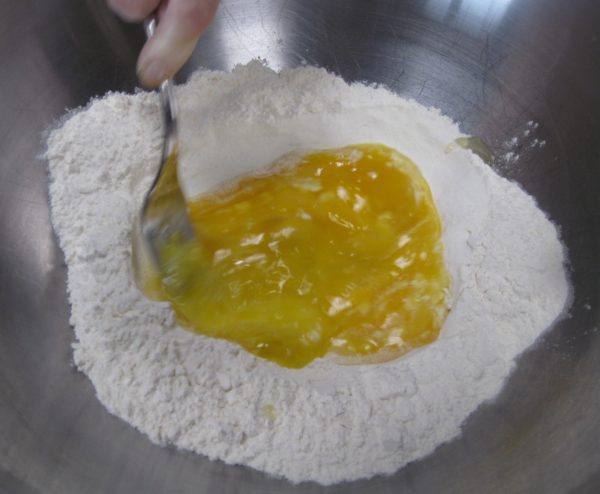
- Add vanilla extract, lemon juice and incorporate.
- Add melted butter.
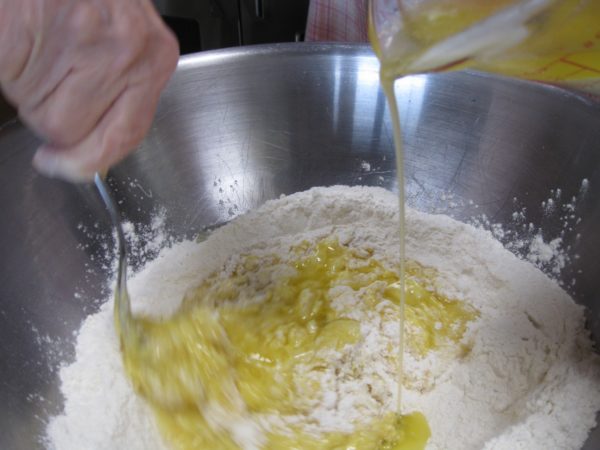
- Mix to form a soft, non-sticky dough.
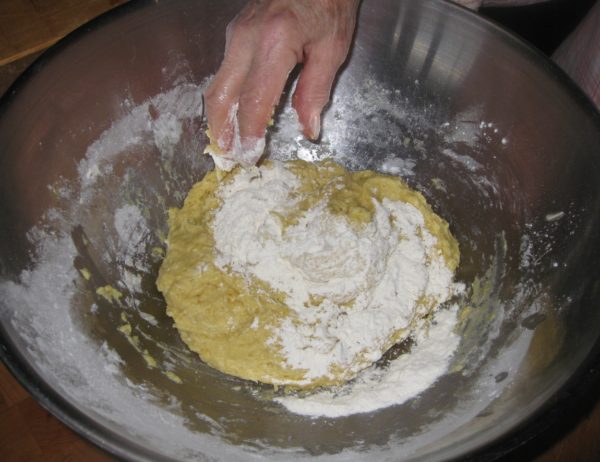
- When the dough becomes too stiff to mix with a fork, use your hand. Do not over knead.
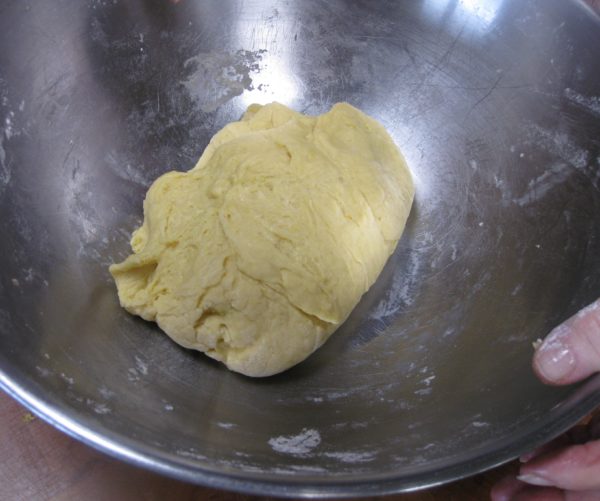
- Cut into four or five pieces.
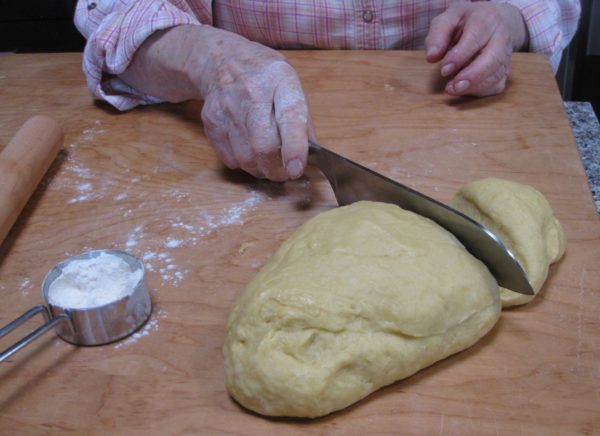
- Roll out less than 1/8 inch thick, dusting with a little flour as needed to keep the dough from sticking.
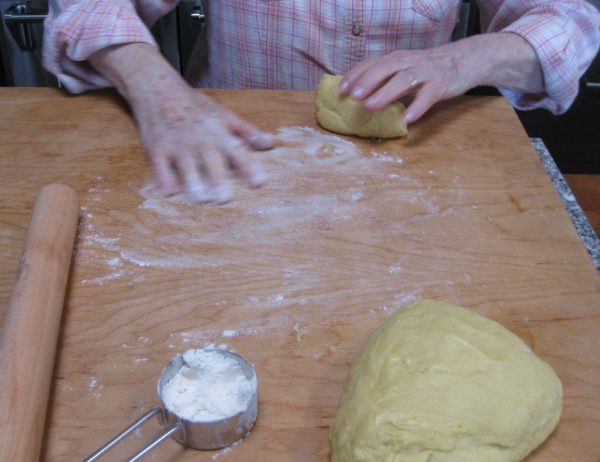
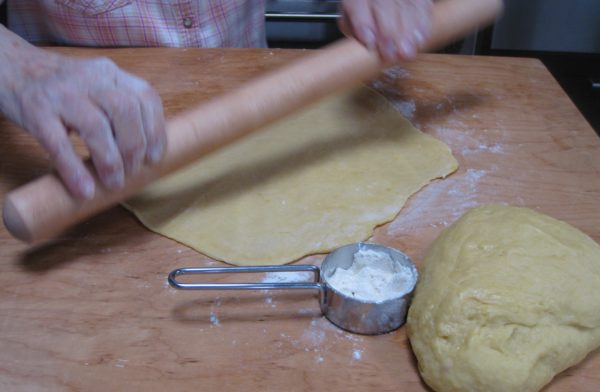
- Cut into rectangles, approximately 1 1/2 inches by 3 inches, with a zig-zag cutter.
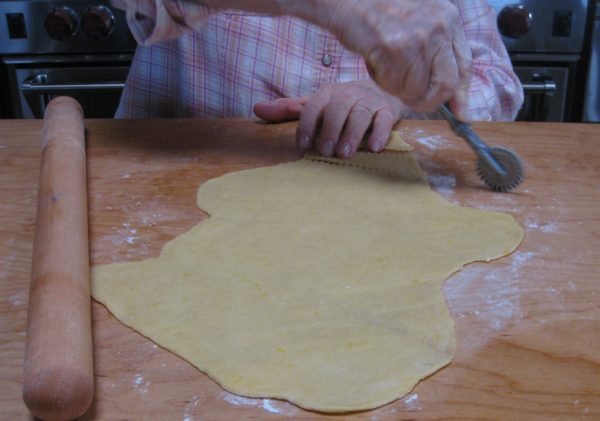
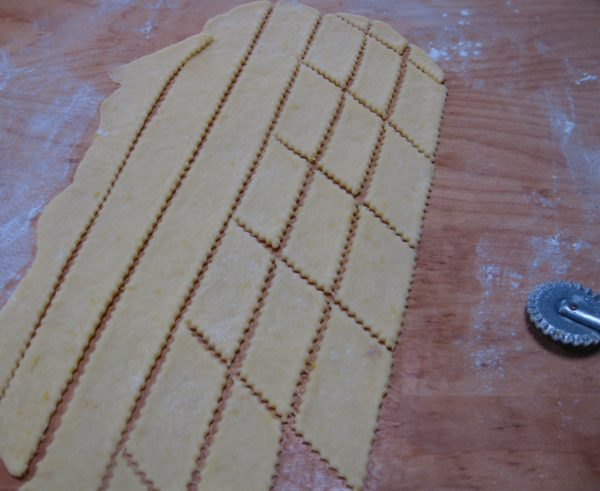
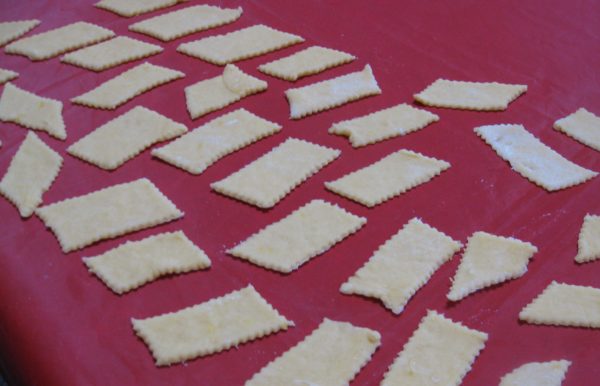
- When all are cut, deep fry until brown. If you are not comfortable doing this from experience, use a thermometer and keep the oil at about 350 degrees Farenheit.
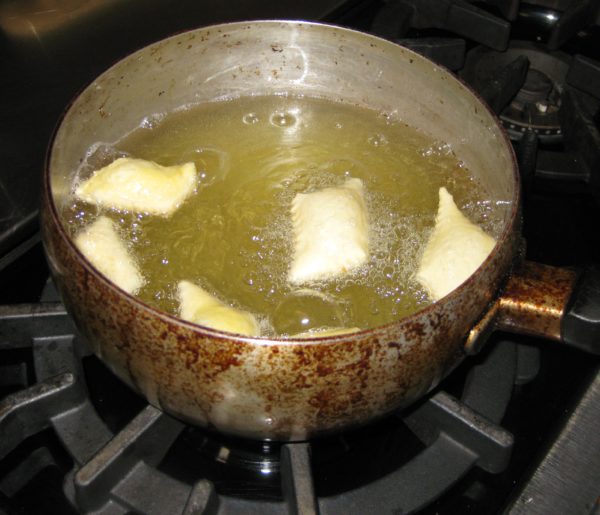
- Sprinkle with granulated sugar as soon as they are removed from the oil so the sugar sticks.
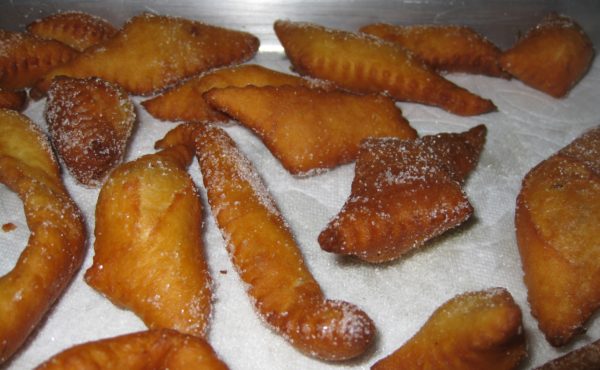
- They are best the same day but will stay fresh at least one day at room temperature, loosely covered.

Copyright © 2017 by VillaSentieri.com. All rights reserved.

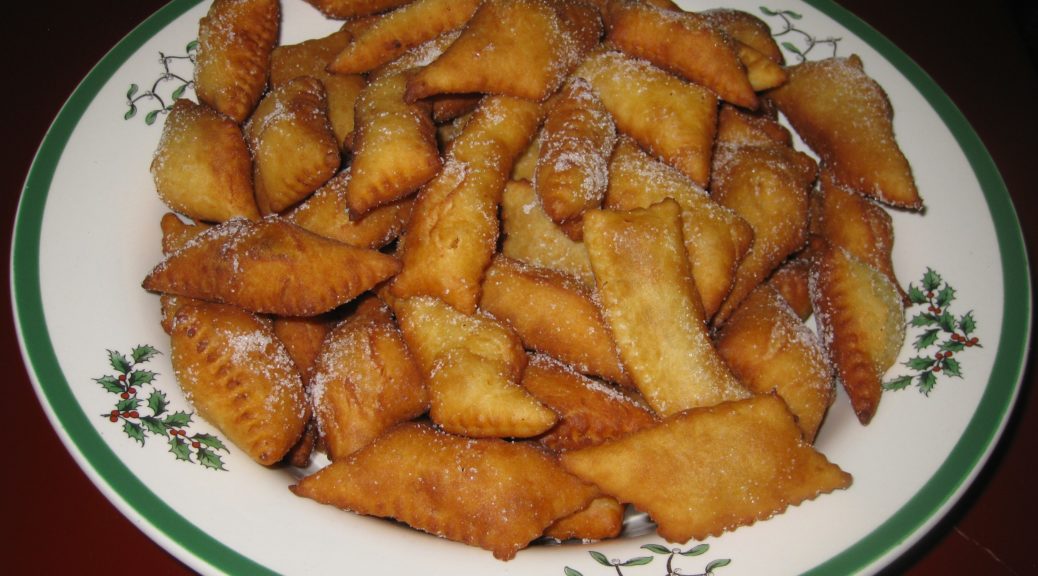
Wow…I am so pleased to have received this current newsletter from Villa Sentieri. It has brought very fond memories of when I was a child and the annual visits to my grandparents with my parents, aunts, uncles and cousins for Christmas where at the end of the meal we all anxiously awaited for the platter of My grandmother’s version of crostoli to be placed on the table.
My dad’s parents were from Bari and my grandmother was an amazing cook. Christmas and Easter were the two times of the year when she would spent hours and days preparing for the family meals that happened on two consecutive days for hours on at the dinner table. Her crostini were the highlight of her offerings. Grandma’s which she called/sounded like ipetua , looked exactly like yours in the photos. However she cut hers into longer strips. The one thing that she added was that she smothered hers in a thick dark sauce made with boiled chicory, coffee, sugar and red wine. The crostini absorbed the sauce and became soft and surprisingly held their shape. But the flavor was incredible and addictive. The presentation was a big platter sprinkled with sole toasted almonds.
For years after Grandma passed away I and an uncle tried to find a recipe, but their was none. As grandma did not learn to read and write, all her recipes were in her head. I remember marveling as a child when I would spend a week or two with grandma and was always fascinated by her cooking with “a pinch of this and handful of that”.
I spent many hours over a year trying to duplicate or find a recipe. All the hours and days of experimenting were disappointing as nothing I made could capture the texture and taste of grandma’s crostoli.
This current newsletter has stirred my interest again. If any of your other readers having Italian heritage have a recipe or are aware of the chicory sauce , I would love for you to share it.
Best Regards,
Tony
Hi Tony, we definitely cut these smaller than usual. They would have been more like your grandmother’s had we done them the traditional way. The recipe you mentioned sounds unique. I’d love to try to recreate it with you if you’re interested. Just let me know.
My mom and fammy make them scallila / crostoli using whisky in the mix. We take a wood dowel and rap 1/2 inch thick rope of go around the stick and pitching it at the top and the bottom. A lot more places for the honey to soak into when you give it a bath
My mother-in-law was Russian (born in Siberia) and the family version of this we called “coudri” – similar dough, rolled flat, tied in a knot and deep fried, sprinkled with powdered sugar. One year we stayed up the night before himself’s birthday party -Dec 20) til about 2am making coudri to serve. The morning after the party I discovered the platterful on top of the refrigerator 🙁 That may be the last time I made it!! Love your recipes xx
I hope you are encouraged to try again!
Well, it’s interesting to hear that Anisette is unusual, as it was standard flavoring for pizzelle and crostuey for us. I see that there are differences in the spelling too (crostoli, crostui, crostuey). Our recipe comes from my grandmother who was from Asti, in the Piedmont Region of Northern Italy. My grandfather, her husband, was from Domegge in the Veneto. It’s possible she got the recipe from his family, but we will probably never know.
This was the first time I made them, but wanted to do it while my mother was visiting for Christmas. My grandmothers recipe was typical of old family recipes, and by that I mean measurements were not precise. Besides the Anisette, her recipe called for “3 glasses of whiskey”. We decided this meant 3 shots, and I used bourbon. I also discovered that they needed much more flour than the recipe called for, and so I kept the dough hook turning a long time as I added flour to get the right consistency. Consequently the dough was very elastic, but the end product’s texture did not seem any different to me, likely because it was fried rather than baked. I often find variations in the amount of flour needed for recipes here at altitude, possibly due to low humidity levels, and differences from one bag of flour to the next.
We sprinkle our crostuey with granulated sugar as soon as they come out of the oil. I add a little powdered sugar before serving to enhance the sweetness and make them look nice. I am intrigued by Tony’s description of the sauce his grandmother poured over her crostoli, and will look online to see if there is a recipe. That would be an interesting new twist!
I’m assuming that next time you will have a better amount of flour required so that the mixing can occur more quickly. Ours came together quickly by hand…no dough hook required though next time I will try to roll them in a pasta machine rather than with a rolling pin. I, too, am enticed by Tony’s comment and hope to work on duplicating his grandmother’s sauce.
In our family, we had something similar at the holidays, but we called them bow ties. They were sprinkled with powdered sugar and were much lighter and crisper than shown here. Will have to find Mom’s recipe (in storage at the moment).
But when my Dad made pizza, he always saved some dough and deep fried it the next day and sprinkled with granulated sugar, though powdered works too. These doughnuts looked very much like Marisa’s crostoli and we kids would nearly trample each other to get at them!
My grandmother(Calabria ) made an anise cookie we called noonagotlia. It was a sweet flavored dough rolled to a this of an inch and rolled around a dowel to shape and then deep fried. Omg- the best. No honey.
Any ideas?
Thank you.
Kathy, my grandmother was from Calabria, too. I don’t remember anything like what you describe. However, I am going to Calabria for three months starting early January for an intensive course on Italian cuisine for professional chefs. I’ll see if I can find out anything.
My mom and fammy make them scallila / crostoli using whisky in the mix. We take a wood dowel and rap 1/2 inch thick rope of go around the stick and pitching it at the top and the bottom. A lot more places for the honey to soak into when you give it a bath
Wrapping it around a stick sounds like a great idea! I’ve never seen it done that way.
My mothers family was from Trissino a Provence di Vicenza. She made these every Christmas. Chiama Grustoli..(Crostoli)?? They are delizioso! She made so many and had to hide them to make them last! I’m going to do it this year!! Grazie mille per il ricetta!
You are very welcome!!
I too have searched for years to find the “tucinelli” recipe my grandfather made. The twisted fried dough with powdered sugar. I have asked every Italian I know and no one seems to know what this is. When I went to Abruzo ( Vasto) this past June there they were! This is where my grandparents are from. They even have a Tuc’nell festival in August each year. 😊 My guide said so much Italian cuisine is regional so the traditions and names stay pretty local.
My grandparents were from San Pietro Avellana and San Michelle in Abruzzi
E Molise region. (Neighbors to Vastogirarde.?) Tucinelli (spelling?) has been handed down as a Christmas “cookie” from my Grandmother. It is great to hear/read that word as we search almost every year to see if other Italians also have this tradition. Our version has raisins, is rolled in a spiral and dunked in honey foam after deep frying them.
I too have searched for years to find the “tucinelli” recipe my grandfather made. The twisted fried dough with powdered sugar. I have asked every Italian I know and no one seems to know what this is. When I went to Abruzo ( Vasto) this past June there they were! This is where my grandparents are from. They even have a Tuc’nell festival in August each year. 😊 My guide said so much Italian cuisine is regional so the traditions and names stay pretty local.